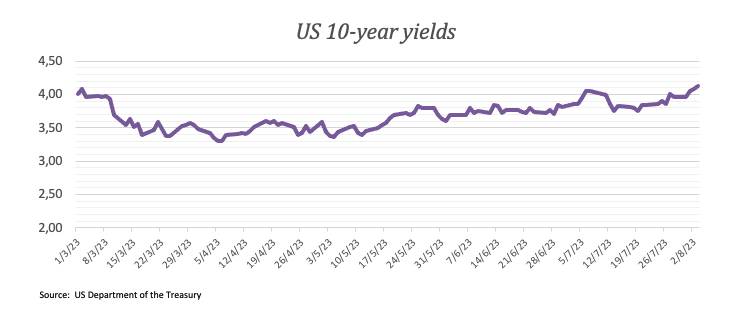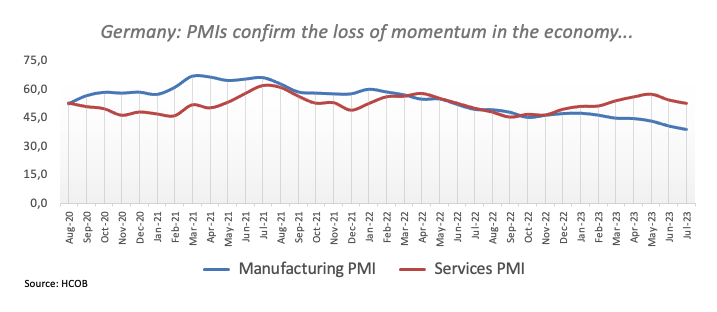Euro bounces off lows, back around 1.0940 as Dollar deflates

- Euro meets support near 1.0900 vs. the US Dollar.
- Stocks in Europe now cut earlier losses somewhat.
- EUR/USD remains under pressure and a breach of 1.0900 appears in store.
- The upside in the USD Index (DXY) falters just ahead of the 103.00 level.
- Chinese Caixin PMI prints showed mixed results in July.
- Final Services PMIs in Germany and the euro area came in mixed.
The Euro (EUR) now manages to almost fully reverse the earlier retracement to the proximity of 1.0900 the figure against the US Dollar (USD), as EUR/USD regains composure and reclaims the area beyond 1.0930 during the European afternoon.
Meanwhile, the Greenback has been performing well and maintaining its rally, pushing the USD Index (DXY) to flirt with fresh four-week highs around the 103.00 mark on Thursday, although that bullish impulse seems to have run out of steam as we approach the opening bell in Wall Street.
The ongoing surge in DXY is closely linked to the relentless climb in US yields, with the belly and the long end of the yield curve reaching nine-month highs of about 4.20% and 4.27%, respectively.
This week, market participants will be closely monitoring important economic data releases from both the US and Europe, which are expected to challenge the recently emphasized data-dependency approach adopted by the Federal Reserve and the European Central Bank (ECB) in their interest rate decisions.
In terms of domestic data, Germany’s trade surplus widened to €18.7B in June, while the final Services PMIs in Germany and the broader Eurozone came in at 52.3 and 50.9, respectively, during the previous month.
Meanwhile, in the US, usual weekly Initial Jobless Claims, the final S&P Global Services PMI, Factory Orders, and the ISM Services PMI are all slated for release later in the session.
Daily digest market movers: Euro’s decline looks contained near 1.0900
- The EUR shrugs off the initial pessimism and retakes 1.0930 and above vs. the USD.
- The USD Index faces some selling pressure following 4-week peak near 103.00.
- The BoE hiked rates by 25 bps, as widely expected, and lifted the policy rate to 5.25%.
- Speculation that the Fed might have ended its hiking cycle keeps running high.
- Market focus remains on the US labour market this week.
Technical Analysis: Euro risks extra decline while below 1.1150
EUR/USD stages a marked comeback from earlier lows in the 1.0900 region, an area also coincident with the transitory 55-day and 100-day SMAs.
The loss of the 1.0910 region, where the provisional 55-day and 100-day SMAs converge, leaves EUR/USD vulnerable to a probable drop to the July low of 1.0833 (July 6) ahead of the key 200-day SMA at 1.0737 and the May low of 1.0635 (May 31). South from here emerges the March low of 1.0516 (March 15) before the 2023 low of 1.0481 (January 6).
On the other hand, occasional bullish attempts could motivate the pair to initially dispute the weekly top at 1.1149 (July 27). Above this level, the downside pressure could mitigate somewhat and encourage the pair to test the 2023 high at 1.1275 (July 18). Once this level is cleared, there are no resistance levels of significance until the 2022 peak of 1.1495 (February 10), which is closely followed by the round level of 1.1500.
Furthermore, the constructive view of EUR/USD appears unchanged as long as the pair trades above the key 200-day SMA.
German economy FAQs
The German economy has a significant impact on the Euro due to its status as the largest economy within the Eurozone. Germany’s economic performance, its GDP, employment, and inflation, can greatly influence the overall stability and confidence in the Euro. As Germany’s economy strengthens, it can bolster the Euro’s value, while the opposite is true if it weakens. Overall, the German economy plays a crucial role in shaping the Euro’s strength and perception in global markets.
Germany is the largest economy in the Eurozone and therefore an influential actor in the region. During the Eurozone sovereign debt crisis in 2009-12, Germany was pivotal in setting up various stability funds to bail out debtor countries. It took a leadership role in the implementation of the ‘Fiscal Compact’ following the crisis – a set of more stringent rules to manage member states’ finances and punish ‘debt sinners’. Germany spearheaded a culture of ‘Financial Stability’ and the German economic model has been widely used as a blueprint for economic growth by fellow Eurozone members.
Bunds are bonds issued by the German government. Like all bonds they pay holders a regular interest payment, or coupon, followed by the full value of the loan, or principal, at maturity. Because Germany has the largest economy in the Eurozone, Bunds are used as a benchmark for other European government bonds. Long-term Bunds are viewed as a solid, risk-free investment as they are backed by the full faith and credit of the German nation. For this reason they are treated as a safe-haven by investors – gaining in value in times of crisis, whilst falling during periods of prosperity.
German Bund Yields measure the annual return an investor can expect from holding German government bonds, or Bunds. Like other bonds, Bunds pay holders interest at regular intervals, called the ‘coupon’, followed by the full value of the bond at maturity. Whilst the coupon is fixed, the Yield varies as it takes into account changes in the bond’s price, and it is therefore considered a more accurate reflection of return. A decline in the bund’s price raises the coupon as a percentage of the loan, resulting in a higher Yield and vice versa for a rise. This explains why Bund Yields move inversely to prices.
The Bundesbank is the central bank of Germany. It plays a key role in implementing monetary policy within Germany, and central banks in the region more broadly. Its goal is price stability, or keeping inflation low and predictable. It is responsible for ensuring the smooth operation of payment systems in Germany and participates in the oversight of financial institutions. The Bundesbank has a reputation for being conservative, prioritizing the fight against inflation over economic growth. It has been influential in the setup and policy of the European Central Bank (ECB).

